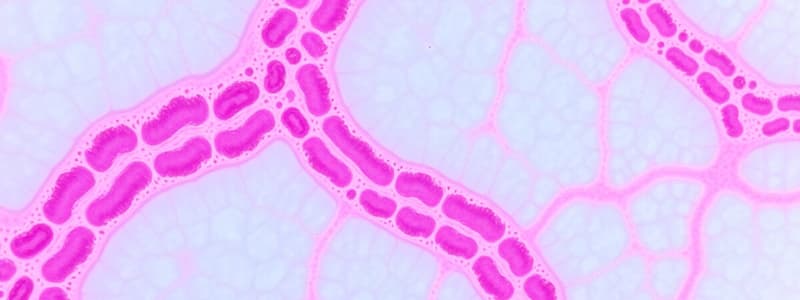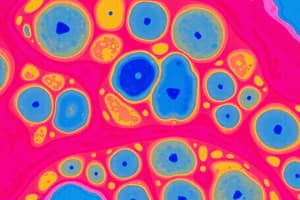Podcast
Questions and Answers
What distinguishes epithelial tissue from other tissue types in terms of vascularity and its arrangement?
What distinguishes epithelial tissue from other tissue types in terms of vascularity and its arrangement?
Epithelial tissue is avascular and is arranged in sheets.
Describe the role of junctional complexes in epithelial cells and their significance.
Describe the role of junctional complexes in epithelial cells and their significance.
Junctional complexes facilitate connection between epithelial cells and maintain the integrity of the tissue by providing structural support.
Explain how epithelial tissue participates in the sensory functions of the body.
Explain how epithelial tissue participates in the sensory functions of the body.
Epithelial tissue contains specialized structures called neuroepithelia that are involved in sensing stimuli such as taste, smell, and hearing.
What are the distinct surface domains of epithelial cells, and how do they contribute to the function of epithelial tissue?
What are the distinct surface domains of epithelial cells, and how do they contribute to the function of epithelial tissue?
Discuss the excretory functions of epithelial cells and their significance in homeostasis.
Discuss the excretory functions of epithelial cells and their significance in homeostasis.
Flashcards
Epithelial tissue
Epithelial tissue
Epithelial tissue is a type of tissue that covers the external surfaces of the body, lines internal closed cavities, forms the secretory portion of glands and their ducts, and makes up the receptors of certain sensory organs.
Avascular
Avascular
Epithelial tissue is avascular, meaning it does not have its own blood supply. Instead, it receives nutrients and eliminates waste products through diffusion from underlying connective tissue.
Junctional Complexes
Junctional Complexes
Cell junctions are specialized connections between epithelial cells that hold them together, maintain tissue integrity, and regulate the passage of substances between cells.
Surface Domains
Surface Domains
Signup and view all the flashcards
Basal Lamina
Basal Lamina
Signup and view all the flashcards
Study Notes
Epithelial Tissue Characteristics
- Epithelial tissue is avascular.
- It covers external body surfaces.
- It lines internal, closed cavities.
- It forms the secretory portions of glands and their ducts.
- It comprises receptors in certain sensory organs.
Epithelial Cell Characteristics
- Cells are arranged in sheets.
- Cells possess specialized intercellular junctions (junctional complexes).
- Cells display distinct surface domains: apical (free), lateral, and basal.
- Surface domain properties depend on specific membrane proteins.
- Cells rest on a basal lamina, a non-cellular protein-polysaccharide layer.
Epithelial Tissue Function: Transport
- Epithelium can function as a transport system.
- Motile cilia on the surface move particles and mucus (e.g., in the trachea and bronchi).
Epithelial Tissue Function: Sensory Reception
- Epithelium can receive sensory stimuli.
- Neuroepithelia (e.g., taste buds of the tongue and retina of the eye) and specialized structures for smell and hearing are examples.
Epithelial Tissue Function: Secretion and Excretion
- Epithelial tissue aids in lubrication by producing mucous and serous fluid.
- It functions in excretion, filtering blood to form urine or sweat.
Epithelial Tissue Function: Reproduction
- Epithelial cells in the ovaries and testes produce sex cells.
Studying That Suits You
Use AI to generate personalized quizzes and flashcards to suit your learning preferences.
Description
Explore the diverse characteristics and functions of epithelial tissues in this quiz. Understand how they play crucial roles in covering surfaces, transporting materials, and receiving sensory stimuli. This quiz will enhance your knowledge of one of the fundamental tissue types in the human body.




